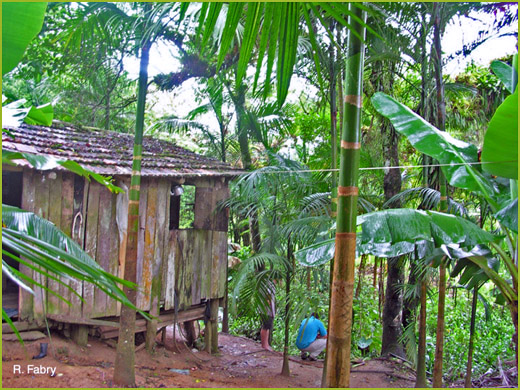Background
Today the Brazilian Atlantic forest is considered a separate ecoregion - in Brazil called the 'Mata Atlântica'. As one of the world's most diverse regions, being particularly threatened at the same time, it represents a 'hotspot' of biological diversity and contributes decisively to the 'megadiversity' of Brazil .
Originally the forests of the Mata Atlântica covered more than 3000 km along the Brazilian Atlantic coast. Due to the geographical situation, the entire region is characterized by high rainfalls. Thus, in the northern part annual rainfall reaches values from 1800 to 2000 mm, in the southern part from 2000 to 4500 mm. Mean annual temperatures vary between 23°C and 25°C in the north and lay at 21°C in the south. Climatically the area stretches from the outer tropics to the subtropics. Thus, and due to a variety of geological conditions, there also exist a diversity of different forest formations - tropical and subtropical forests, coastal and mountain rain forests, mangroves and beach forests.
The region, comprising the 'mega-cities' of Rio de Janeiro and São Paulo, is inhabited by more than 100 million people.
Due to high population pressure, agriculture and industry only 5% of the original forest still exist and even these rests are at great risk. 1992 the United Nations declared this valuable ecosystem a Biosphere Reserve, which has been extended to 15 states by now.
To counteract the increasing destruction of this 'treasury' of biodiversity, in 2003 a large-scale research project was launched by the German Federal Ministry of Education and Research (BMBF) and the Brazilian Government (CNPq). Under the project title 'Science and Technology for the Mata Atlântica' German and Brazilian scientists from different disciplines deal with the question how the last species-rich remnants of the Mata Atlântica can be preserved for the future. The program aims to develop strategies and action plans for the conservation and sustainable use of this unique habitat.
Besides the SOLOBIOMA project the long-term research program includes three other projects:
- 'Sustainability of remnants of Atlantic rainforest in Pernambuco and its implications for conservation and regional development' (Recife)
- 'BioCAPSP II - Biodiversity conservation in fragmented landscapes at the Atlantic Plateau of São Paulo' (São Paulo)
- 'Internal dynamics of rain forests: specificity of interactions between bromeliads and the associated fauna' (Florianopolis, Santa Catarina)



